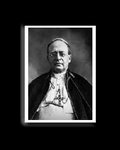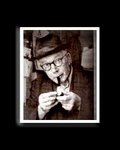Having read lately the words of the great Hilaire Belloc on modernity's ignorance of books and their importance (I'd encourage readers who aren't familiar with the work to read through it themselves, at Belloc Speaks: On the Decline of the Book), I thought I'd extend that to the decline of the mechanical art of the book---that is, to the simple make-up of a good, sturdy book. Like most crafts, that of bookbinding has suffered a vast decline in the modern age; but once, the make-up of a book was a piece of great artistry and talent.

Most modern readers will blink a little bit at this and, after remarking that they like a well-put-together book as much as anyone, will be perfectly satisfied with their paperbacks or hardcovers and never think another thing about it. But the fact is that modernity, thanks to the sort of thinking that gives rise to both capitalism and socialism, has destroyed a once great art, an art that deserves learning and maintaining for our descendents. That is the subject of this article.
I begin by saying that this article owes absolutely nothing to my own skill in this ancient art, which is slight and halting. For the knowledge contained herein, I am indebted first and foremost to the master binders at Colonial Williamsburg, who spent four good years answering my constant inquiries despite the fact that they didn't even know my name. Much of the technical knowledge, which could not be gained without an apprenticeship, I have acquired through reading, most especially Douglas Cockerell's Bookbinding and the Care of Books and Edith Diehl's Bookbinding: Its Background and Technique. Those interested in this most important craft are encouraged to seek further information there.
Books were once precious; purchasing one might take a month of an average man's wages, and the vast majority of the populace owned none or only one or two (generally the Bible or a Primer). The rich owned many, and the Church, of course, had many; but each of these was a work of art in itself, even speaking purely mechanically, independently of its content. Books carried knowledge, and knowledge is power; they imparted wisdom and understanding to those who understood them, and were formed and cared for appropriately considering this great, almost mystical, property which is uniquely theirs.
The book was a long time in developing, and always got better and more sensible until the arrival of modern economical philosophies rendered art a financial liability and artlessness an inducement to profit. A brief history of this development, drawn more or less entirely from Diehl's excellent work mentioned above, will be helpful in determining what I mean.
The first set of records put together for a specific purpose was the "foundation cylinder." Symbols were inscribed upon the outside of the cylinder, and the reader turned it as he read; when he had turned it all the way around, he had read the entire "book." This is, clearly, a cumbersome way of recording things, and is suitable only for short passages. A better form had to be devised.
It was followed by the clay tablet, a simpler though larger form of record, which was first used by the ancient Babylonians. Often the writing would continue from tablet to tablet, and they would be covered and organized by subject matter on shelves, just as books are. The first library in recorded history was of clay tablets, at Nineveh. It was destroyed along with that city at the fall of the Assyrian empire.
The classical scroll was first used in Egypt; papyrus sheets were pasted together, and the writer simply continued pasting until he was finished. The roll was then tightened and placed in a cylindrical container. This held writings very compactly, but was cumbersome to read, requiring the unrolling of the scroll in such a way as to prevent its complete unravelling but still permitting reading. The material of papyrus was used for millenia, but greatly limited the form of records. It was too brittle to be folded without breaking, which meant that it could never be used for a book. So the scroll was the only acceptable form until a better writing medium was devised.
That medium came with the invention of vellum. The skins of animals had been used for writing before, but they had always been prepared by tanning, like other leather. Vellum, however, is prepared not by tanning, but by another process too complicated to enter into here, though Diehl treats it in some detail. For a time vellum was used in scrolls just as papyrus was; however, the material permitted a superior form of record to develop.
Scrolls were generally inscribed (that is, written upon) in one of two ways. First, the lines would sometimes be continued all along the length of the scroll, then returned to the beginning. This was somewhat cumbersome for later reading, so the second form developed: continue the lines along the length of the scroll for some sensible distance, then return to just below where the first line began and start again. Continue doing this until one reached the bottom of the scroll, then start a new column. Essentially, this made a scroll a long line of pages lined up one after another. The new medium of vellum allowed these pseudo-pages to become pages in fact.
Somewhere in the Middle East, someone got the idea of folding the scroll, to make it into a pile of these "pages" that could be unfolded as one read. Two boards (unattached to the folded "scroll") were placed on top and underneath to keep the folds flat. This, of course, lent itself to another development: why not cut the folds off on one side, and keep the other side bound together, allowing one to just flip through the pages rather than having to unfold one side and fold up the other as one read? When the backs of these books were bound, and the boards on top and bottom were attached (now to protect the pages, rather than merely to keep them flattened), the early Christian codex was born. This was, for all intents and purposes, our book.
Such is the power of this seemingly simple form that no less a rationalist and scientific utopian than Isaac Asimov, in "The Ancient and the Ultimate," described the perfect form for preserving our thoughts and ideas for the future and for other men: nothing other than our ancient, perfect book. Yet despite its apparent simplicity, man took four thousand years to develop it, eighteen hundred years perfecting it---and only one hundred and fifty destroying it. But I'm afraid I'm moving ahead of myself; the book has still only just been made.
Throughout the Christian era, the book's form was strengthened and made more permanent, more eduring, to befit most of the material which was being bound, the classics of pagan and Christian philosophy and, of course, of the Christian religion, especially the Scriptures and books of the Sacraments. Gradually, the boards came to be attached to the manuscript itself; cords were sewn to the signatures, or leaves, of the book, and they were then laced into the boards (generally oaken, at least in northern Europe), ensuring the permanency of the binding. These boards would then be covered by leather of many types, from pigskin to lamb. The medieval craftsmen withheld no effort or expense in their quest to make permanent, beautiful volumes; the cords used for binding were not single, but double, and made of leather; even the head and tail guards were sewn throughout and laced into the boards. This was the age when binding, as such, truly came into being; these books would last for centuries, and when they finally did wear out, after five or six hundred years, they could be unbound, the paper still intact, and rebound with new boards and covers.
The medieval diligence was relaxed somewhat with the invention of printing; the volume of books was simply too great to permit such extravagance with every project. However, permanency and beauty was never sacrificed; the cords were no longer doubled, perhaps, and the boards were no longer wooden; the head and tail guards were not sewn throughout, nor were they laced in. But the quality of these books was still superb; and the stronger, older bindings could still be executed for books of particularly lasting value, like the Scriptures or the breviary.
A summary of the condition of the book at this point (call it the late eighteenth century) would be helpful. Books of any lasting value (that is, everything but propaganda tracts, almanacs, and the like) were printed mostly on paper, not vellum; however, this was rag paper, not wood pulp paper, and would last literally for centuries without deterioration of any significant kind. I personally have handled four-hundred-year-old rag paper and found it still supple, not at all brittle, and though it had been handled repeatedly and even occasionally roughly it was in perfectly legible and sturdy order.
Many "pages" of the book were printed on a single sheet of this rag paper; the bookbinder took these large sheets (often called "broadsides," on which newspapers are still printed) and folded them appropriately so that the pages would all appear in the proper sequence. These folded sheets are known as "signatures." The binder then pressed the signatures for several days to ensure that they would lay perfectly flat; this done, he put the back of the book (what we now would call, improperly for modern books, the "binding") against cords, made of acid-free linen (medieval binders used leather, stronger but stiffer), generally five in number, and sewed each and every signature, by hand, to each and every cord, adding a "kettle-stitch" about halfway between the final cord and the end on both the top and bottom of the back. He used linen thread for this, as well; cotton deteriorates too quickly, and tends to be weak under pressure. He later laced the cords firmly into the front and back boards (what we'd call, properly for modern bindings, the "covers"), to ensure their firm attachment.
The signatures sewn, he began a complicated process known as "backing," in which the back ("binding") of the book was treated so that it would open freely and easily (indeed, such books could be opened and folded back on themselves without any harm to the back itself, though with today's books such activity is disastrous). This involved many steps, not least of which involved covering the whole of the back in a fine layer of hide glue (too much would make the back brittle; too little, weak). It was important to ensure that the curvature of the back was precisely correct, or the book would be too "tight" (that is, it would not rest open, but constantly try to
close itself by the force of its back). Furthermore, the few signatures at the beginning and the end of the book had to be knocked down, so that, when the boards were added, they would form a tight joint, without knocking them down so much that they would overlap, and possibly lose parts of their texts into the binding. This was rightly considered the most delicate part of the process, short of decorating the actual covers.
After the book was backed, the binder would put on the head and tail pieces (small lines of linen on the top and bottom of the back; these prevented the pages from getting caught or worn when the book was removed from or replaced on the shelf, and were often quite an art form in themselves).
Then the boards would be added. These were not simply pasted to the end papers (the blank sheets on the top and bottom of the book), as they are in modern books, but were firmly attached and seen as an integral part of the volume. When the book was backed, the binder had knocked down the two edges of the curve to provide a spot for the joint between the back and the boards. Now, the boards were fitted into that joint. The location of the cords were marked on the boards; the boards were removed, and the binder then punched holes in them at the proper locations. He then replaced the boards in the joints, one at a time, and laced the cords (already sewn, remember, individually to each and every signature) through the boards. Care was taken that the boards were not attached too firmly, lest the book not open far enough or easily enough; properly, the book should, when opened and set on a table, rest opened without any tendency to close itself, and without any damage being done to the binding (note that in modern books this behavior can only be achieved by "cracking" the binding, which completely ruins what little strength it has). This completed, the book was ready for the final step: the covering.
The binder had several choices for covering, conventionally known as the quarter-cover, the half-cover, and the full-cover. The quarter cover consisted of leather wrapped around the back of the book and over part of the sides; it was rarely used. The half-cover, much more common, consisted of a quarter cover embellished by leather also wrapped around the two fore corners; it was common for utilitarian volumes like bankbooks. Finally, the full cover, utilized for any book of lasting and significant value, consisted of leather wrapped around the entirety of the book. This cover would often be decorated, as explained below.
We'll presume a full-cover here. The leather was first treated; not chemically, but with a special blade called a "paring knife." The leather was pared, or thinned to the appropriate thickness. This had to be done with great care, lest the leather be thinned to the point that it was no longer strong enough to protect the volume. Various parts of the leather were kept thicker, and various thinner, depending on where strength and flexibility was most needed. The precise spots would vary based on the book itself and how its construction had proceeded. Especially important to pare were the edges; these had to be wrapped around the edges of the boards, and if too thick would prevent the book from closing flush to the pages, but if too thin would be prone to tearing from the edges of the boards.
Different types of leather would be selected. In medieval times, especially in northern Europe, pigskin was common; this was strong, of course, but also comparatively inflexible. By the heyday of the binder's craft, the early to mid eighteenth century, two types of leather were recognized as the best: skiver, or lambskin, which was strong but so thin that it scarcely required any paring, and Moroccan goatskin, which was highly valued for its skiver-like characteristics combined with its delightful reddish color.
The binder then applied a layer of wheat paste to the entirety of the inside of the leather; he then stretched the leather in one piece around the whole of the book. This had to be done quickly; the moisture of the wheat paste expanded the leather, and it would shrink as it dried, so it was important that it be in its proper place before the shrinkage began. Especially difficult were wrapping around the corners and at the binding, as the leather had to be folded properly behind itself at the binding, where there was no board for it to be wrapped around. Some edges, once the cover was on and dried, would be snipped; then the end papers were pasted on, over the edges of the leather. Remember that this was rag paper, and the paste did not have the ruinous effect that it has on cheap modern pulp.
It is important to note that for the master binder of binding's golden age, the cover served two purposes: strength and beauty. It did not hold the book together; it made the book stronger, more resistent to the elements, easier to use, and more beautiful. But the binding, the part that really held the book together in one piece, had already been done before the leather was even pared. That is, it was the binding part of the book: the backs of the signature sewn to the cords and properly backed. The cover added to its strength, but it did not form it. The book was firm and strong before the leather was ever added.
The leather would then be decorated, if desired. This decoration could be as elaborate or as simple as the nature of the book and the desire and talent of the binder were able to justify. The cover was decorated either with blind tooling (simple designs imprinted on the leather) or gold leaf (blind tooling into which real gold leaf was placed). Many binders created works not only of solid material craftsmanship, but also of stunning artistic beauty in this way.
Of course, shorter-lived books were bound differently; once pressed and flattened, the binder simply punched three holes from top to bottom on the back, then laced it together through them with some sturdy linen cords. This would do for works of only transient significance, such as almanacs, short stories, and political tracts (and was indeed considerably sturdier than most of even the strongest modern bindings). But lasting works were done as just described.
This, then, is the condition of the book after fifteen hundred years of development, the art being passed down and improved from master to apprentice for a millenium and a half. The book is a craft and an art; its focus is on quality, strength, and beauty first, and the profitability of the trade only second. Then, however, enter modernity and capitalism; the whole art begins to break down.
The nineteenth century began the doom of this great art. The first blow was the development of wood pulp paper; this supplanted almost entirely (and continues to supplant) the use of the studier and nearly immortal rag paper which had previously been used. This paper begins to deteriorate after a mere decade or so; if treated very well, it may last for a century or more, but only if treated very well. But the old rag paper lasted centuries even when treated badly and used heavily. This was unquestionably a step down, and began the change for bookbinding from long-lasting art to merely profitable business.
Bindings began to be reduced in quality. With signatures sewn strongly and beautifully on cords, the cords show through on the back, providing a beautiful and functional reminder of the book's solid craftsmanship and strength. For whatever reason, however, it became stylish to have smooth backs, and so binders, succombing to the all-important profit motive, often sacrificed the integrity of their craft on the altar of increased gain. They sawed into the backs of the signatures and embedded the cords within; this significantly reduced the strength of the back and the longevity of the paper, which with the introduction of wood paper had already been immensely reduced. Eventually, they began to sew the signatures on mere flimsy tapes, rather than the sturdy linen, or even leather, cords; this gave rise to the phenomenon of books only five or ten years old literally falling apart at their seams, the bindings sadly lasting even less time than the low-quality paper they attempt to hold together.
Soon, even true binding was abandoned; rather than binding the entire set of signatures together, a mere fraction of the signatures were sewn on three, rather than the usual and sensible five, cords. Soon, those cords were even eliminated, being replaced with flimsy plastic tapes. Most of the job of "binding" (that is, holding the signatures together) was now done by a layer of paste wiped over the back, a sad substitute for the strong bindings of the prior age. Those flimsy tapes were no longer laced into the boards, either, thus truly binding together the signatures, the boards, and the cover, but rather the boards were attached to the signatures only by the endpapers, pasted to the inside of the boards (once only one of the many ways in which the book was held together), and the cover (rarely if ever leather) merely wrapped around that, completely separate from the binding. This would rightly have shocked the traditional binder; the book is no longer really bound, but merely cased, with boards on either side, going almost all the way back to the old codex. The art, and even the trade, of really binding had died; now mere casing, almost universally mechanical, controls.
And all this decay, remember, is entirely hardcover; we have not even begun to mention the inferiority of paperback "bindings."
Why did this happen? For the same reason that all the great traditional crafts have been broken: the love of money. Binders (and, more often, their employers) could sell more books for less, and thus make greater profit, the lower the quality of their bindings. The average person, unschooled in the ancient art, won't know the difference, thinks a book is a book, and will simply buy without worrying about it. This is the death of crafts and the severe wounding of art, and a capitalist will never worry about it. Why should he? It must be good; it's increased the profit margins.
That's the reason that, for example, great architecture is practically never produced, why the capitalist age has never produced anything even remotely comparable to the Gothic cathedrals or the great palaces of the old world: there's no money in it. People need places to stay and do things; they'll stay and do things in a mediocre building just as readily as in a beautiful one, and it's much cheaper to build that way. They'll fancy a building up, of course; people like perks. But beauty isn't always profitable, so capitalism doesn't need it. Herein lies one of the greatest evils of capitalism (and with it, socialism, though for an entirely different reason): it kills art in the name of merely material gain.
This situation in books is parallel to that of many once-great arts, and many arts which could become great if not stifled by the all-powerful necessity of seeking the greatest possible profit with the least possible expenditure. What can the distributist do, practically, to help slow, or even reverse, this process? What we can do for books will provide some principles for what we can do with everything, even though naturally the details will change according to the subject.
For books, the first step is the most important: print fewer books. There is no need for the vast quantity of print that is churned out of publishing houses year after year. Certainly, there is no need to go back to copying vital manuscripts by hand; a large volume of books is a valuable and important thing. But a large volume of books is useful only if it is a large volume of good books. Can we honestly claim that the books which moderns are constantly cranking from the presses are vital to human flourishing? Some of them are, certainly; but the vast majority are frivolous, unnecessary, and often positively harmful publications that ought never to have been printed. They are published not because they will edify their readers, enlighten the populace, or serve to build virtue in society; they are published because they will sell well. To foster the mechanical art of books we must eliminate such frivolous publication. The fewer the books and the more important their content, the more likely that men will see their value and prepare them mechanically in a manner worthy of their subjects. Further, the fewer the books, the fewer men will buy; this will not only focus their attention more on the contents of those books, having less frivolous nonsense to read, but will make men more willing to spend the necessary funds on quality binding for those books, since they are buying many fewer. Granted, this point is beyond the purview of the binder and within that of the printer, but it's a necessary step in the process.
The second step is equally simple: guage the quality of binding based on the importance of the book. For example, when binding a copy of Holy Writ, the best of bindings is not good enough; we must always execute the most permanent possible binding for such volumes. Books of the Sacraments must be likewise treated with the utmost respect. This is difficult to understand, sometimes, in these postconciliar days, when new "translations" and "editions" and outright revisions of the sacred rites seem to be published every week or two, but when the world returns to some measure of sanity it will thank us for our care and foresight. Sacred books deserve only the best; we would not offer the Holy Mass with a mere wineglass, and neither should we hold our Scriptures in a low-quality paper case. Some books are more important than others, and ought to be treated as such. This will allow the binder to handle a large volume of books, and even make a profit from them, while still preserving the full glory of his craft where it is truly needed.
Most importantly, of course, and also the sine qua non, is what distributists have been saying since the notion of distributism was invented: institute and live out the Social Reign of Christ the King. Remember Christ, and remember that greed should not be the driving force of the economy. Encourage and enable craftsmen to free themselves from their employers and become their own masters, which will also free themselves from the demands of corporate profitability. Then, remind craftsmen that there are more important things than turning an ever-increasing profit far beyond what anyone needs to maintain themselves and their families. Hearken them back to the guilds of past ages, who carefully set their prices to ensure both affordability of their products, sustainability of their craftsmen, and, most relevant here, the integrity of their craft. Modernity doesn't care about craftsmanship unless it makes them money, and in this case it just doesn't make enough for the ever-increasing appetite of modern man. But a craftsman loves and values his craft; if he can make a living, he will settle for his living, and refuse to sacrifice his craft for the sake of getting more.
Our society does not encourage craftsmen; it encourages businessmen. Thus, it does not encourage production of works of craftsmanship, but rather of money. Let us try to change our society; let us focus once again on using our God-given talents not to produce greater quantities of digitized green paper, but on producing works of value, of beauty, and of grace. Only by submitting ourselves and our society to the rule of Christ the King can we overcome our greed and selfishness and focus instead on doing good. Let us work for and welcome that reign; only in this way can we regain this and all the other lost crafts and glories that we once raised up to our Savior.
I conclude with the prayer to our Almighty Father, that through the intercession of the glorious and immaculate Virgin Mary, the Mother of God, the ancient art of bookbinding might return to its former glory, and the holy and elevated things will again be esteemed and treated as the precious things that they are. Through Christ Our Lord. Amen.
















9 comments:
I would frankly love a craft book industry to prop up -- I'd personally love to, when I am more financially settled, to be able to purchase a truly fine copy of the vulgate, or the Duay-Rheims.
Frankly, however, I'm happy that cheap paperbacks are available. I'm happy that I was able to purchase Plato's Republic, Aristotle's Nichomachean Ethics, and the Summa from Amazon for less than I make with an hours work. I have access to all the classics, as well as the writings of Tolkien, and yes, even some modern sci-fi and fantasy that I rather enjoy. I like the fact that for a modest fee, I can get invaluable books in my field, which isn't old enough to have classics. I like the fact that I can own several copies of the traditional breviary -- so my fiancee and I and our friends can chant vespers together.
Why would it be a good thing if I had to spend a month's salary on a book? How would that lead to a more educated world? I guess it's good enough that only the richest men can become scholars?
"I'm happy that I was able to purchase Plato's Republic, Aristotle's Nichomachean Ethics, and the Summa from Amazon for less than I make with an hours work. I have access to all the classics, as well as the writings of Tolkien,..."
There are libraries. This is the way that many people without the means to purchase many books even at our absurdly deflated prices still read. Church libraries are built around this notion: people should have access to quality writing without the need to pay anything. Surely this situation is not prohibitive to spiritual gain and scholarship?
So your last paragraph is a non-sequitur. The greatest scholars in the medieval age, when books were so expensive they were often literally chained to the shelves, were the poorest: the mendicant monks, not least St. Thomas Aquinas. They owned no books of their own, but read them in *libraries,* often in groups to make the greatest use out of a single volume, and studied them in *classes*.
Your objection applies even less in the digital age, when the classics are almost universally available completely free in digital form. Try http://www.corpusthomisticum.org, or http://onlinebooks.library.upenn.edu/webbin/book/lookupname?key=Aristotle, and so on, for just a couple of the more important examples. Project Gutenberg will yield many, many more.
But in any case, it's perfectly reasonable for a craftsman binder to produce lower-quality bindings even of such works (though craftsman "low-quality" bindings are considerably better than most of even the best modern bindings) for wider distribution. Texts intended for students, for example, or for wide distribution at a parish (say, Vespers books; an entire breviary seems overkill if one only wishes to pray Vespers).
The point is that the *use* and the *subject* of the book should dictate the way in which that book is prepared, and that it should be craftsmanship, not profit, which guides the binder. I can see how one might read the article to forbid such things, but I didn't intend to do so. *Every* holy text need not be bound in gold; but they should be bound with a view to their importance and their likely use. Which modernity does not do, because there isn't enough money in it.
And your field doesn't have classics? You're a software engineer, aren't you (so sayeth your profile)? What about Kernighan and Ritchie? "The Camel"? _The Art of Computer Programming_ (and anything else by Knuth, for that matter)?
Knuth is the closest thing to a classic we have, and I'm rather fond of the GoF Design Patterns. Classics, however, they are not. Languages and theory are still drifting. OOP is still evolving quickly as a concept, and the paradigm shifts greatly in dynamic languages like Ruby and ECMAscript. The field is simply too young to have even judged whether such works are classics -- closer still would be von Neumann or Babbage, with their theoretical underpinnings of computer science. It is still an impoverished discipline -- languages are too inexpressive, and bugs are tolerated where they are not in every other engineering discipline. I believe through evolution of language paradigms, more rigorous engineering practices, and growing up, we can get there, but we're not yet.
Alas, I've gotten off topic. Even your craft bookmaker's "lower quality" bindings would cost astronomically more money than the $4-6 classics I can purchase today.
I know not what libraries around you are like, but I wouldn't feel comfortable taking a child to a library today. The sheer volume of filth outnumbers the classics. I'd rather have a home library with lower-quality bound works and the ability to expand it at will.
I know not what libraries around you are like, but I wouldn't feel comfortable taking a child to a library today.
Must the entire reform of society be accomplished all at one stroke? This is the problem, and I find it a continual them in your arguments as well as Samwise's, that you can only see the distributist mindset in terms of the here and now. You can't picture how the rest of society follows in the process of reform. Mr. Goodman did not say to constitute libraries as they are, but Church libraries. I wouldn't go into a library as it is except under great need. Yet suppose a library was developed as a cooperative, outside of the arm of the state. The current library system is filled with leftist thought, that the classics should not be available but filth should be. Suppose we took it out of the hands of the government and put it in the hands of local people who maintained it, principally the Church since the Church could do so in the most cost effective manner. Then you have the chance not only to obtain a large selection of good books, but to filter out the smut as well. It simply needs to come out of the hands of the government so long as they are enamored with the rights of pedophiles and sex addicts.
Athanasius, the changes you envision regarding the library do not require a switch to distributism. And besides, I like being able to own the books I read! Not only can I refer to them quickly, but a personal library is a nice decoration for a home. I envision having a giant collection taking up several shelves when I have my own place. Since everyone else is, as you admit, happy with the state of things, how about you prop up the craft book industry as has been suggested, and leave the rest of us to our paperbacks.
Aaron Traas, you're a good and tireless man- keep up the good fight!
@crusader88:
Wait---so you're arguing that we should allow a once-beautiful craft to be completely demolished because a library in your house *looks pretty*?
One can answer in two ways to this assertion:
1.) Well-crafted books look much, much prettier than the fudge we purchase today.
2.) The hierarchy of goods clearly indicates that the goods of craftsmanship, economic viability of local binders, and bindings suitable for their contents is far more important than each and every man having a mildly attractive (what attractive paperback bindings are you purchasing, anyway? I rarely find any) personal library.
@aaron traas:
"Even your craft bookmaker's "lower quality" bindings would cost astronomically more money than the $4-6 classics I can purchase today."
On what basis are you making this statement? You state none. I posit that a local, craftsman binder could easily produce a volume cheaply bound, but still better than the paperbacks on our shelves, for very little money. Such books are merely pressed, then several holes punched through at the back and bound together with some twine. These are eminently affordable for common men---as they always were, for example, with almanacs, which were commonly purchased by even the poorest freeholders in the eighteenth century.
As for your breviary or your primer, read some Duffy or some St. Thomas More---you should be able to find both at your library, as I suspect little or any is in the average Catholic's personally library. As early as the sixteenth century, most everyone had a primer, rich or poor, and that primer was bound according to the best practices of the time---indeed, many of them survive to this day. The point is that such volumes are *worth* the extra expense.
If we're not willing to spend the extra money on such a thing, we're displaying exactly what we think of them. In the same way, we wouldn't set a diamond in rusty aluminum; rather, we set it in the finest gold or platinum, as befits its nature. Yes, this makes diamonds more expensive, less accessible. But the point is that this is in perfect accord with the stone's nature.
This is coming from a man who has an extensive collection of books, numbering some 750 volumes. I need these because libraries rarely carry many of them. I'd quite happily forfeit them all in exchange for a library full of well-crafted books that could be shared by the entire community, rather than duplicated by each member, buying a few very precious ones and professional ones for my own use, plus more low-quality-bound ones where necessary.
Scylding: There are five volumes in Macaulay's History; I only have four of them. I suspect you don't have them all; if all five volumes were bound into one book, that would be a hefty tome! Vol. IV extends to the end of the life of William of Orange. My edition was published in 1899 by Houghton Mifflin.
I'd like to know book binding myself, where I could re-bind some of the really old books I have. Some of things I've learned is that after Vatican II there has been this book-burning thing with Catholic schools and colleges where books older than a pre-defined date are burned or garbaged, and then I was told about these large book companies buying up whole trailer fulls of books from used book stores and thrift stores and throwing them onto a mechanized conveyer that shreds books without the code that is found in modern books, so all books printed before those codes were imbedded go straight to the shredder.
And then there's the cost of books these days, there's no sense in my paying 15-50$ for books that are printed for 3-5$ and stocked for 1-2$, and then mult-volume sets are outrageously expensive, this is known for fact, they are inflated just because they are in volumes, one seller will sell the same four-volume set as one that sells it for $90 for $130-140. And buying old books are expensive just because they're old! I'm a bookworm and I like to read good Catholic literature, and collect it, but I don't have the money to actually own in hardcopy all the books I would like to own for my own purposes, and be able to hand down to future generations that same edifying knowledge. But modernity will have its way. At least I was able to get some literature.
It looks like I am getting in on the discussion a little late. Hopefully someone will read my post. I recently bought and read the paperback book, 1491, by Charles Mann. I read the book in about a week. Before I had finished the book, a huge section of it had become separated from the cover! Another book of mine, which I had hoped would hold together much better, The Discovery And Conquest Of Mexico by Bernal Diaz Del Castillo, split internally into two pieces before I was finished reading it (I later lent this "new looking" book to a friend, and he was horrified because he thought he had done the damage when he opened it). Shoddy construction seems to be rampant in books being sold. A book should not fall apart after the first, second, third, or even fiftieth reading.
I like the idea of the craft of bookmaking being revived. Certainly the books used at Church (the Bible, missals, and hymnals) could be produced in this manner. Instead of having hymnals that are thrown away every year, we could have real works of art that would be worthy of the Mass being celebrated. What about reviving th art of illumination as well. Wouldn't it be nice for each Church to have an illuminated Bible?
I have visited several of the mission churches in California, established by Blessed Junipero Serra. The Missals and chant books these early missions had were beautiful.
Hopefully we can find our way back to the level of craftsmanship and appreciation of beauty that in the past was normal.
Post a Comment